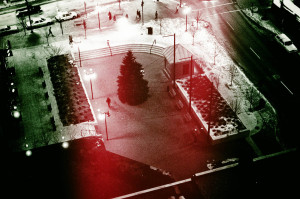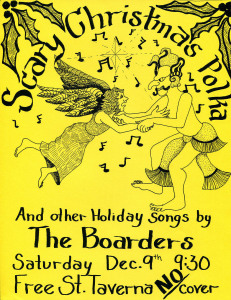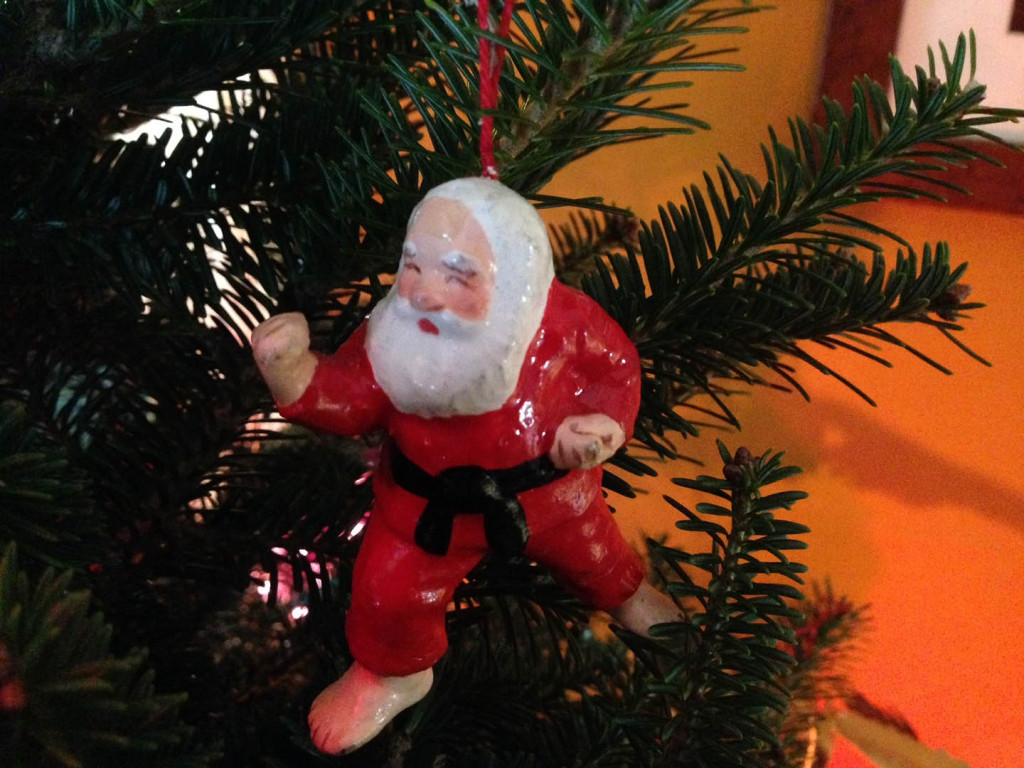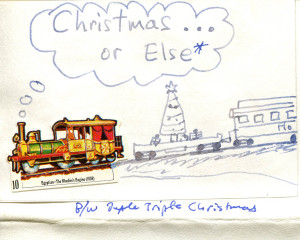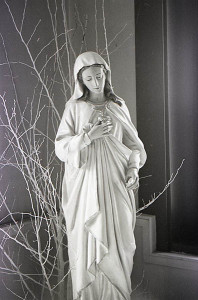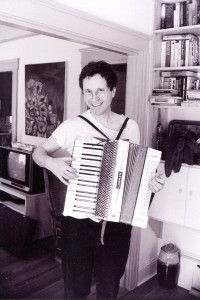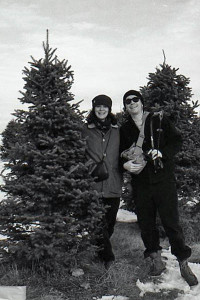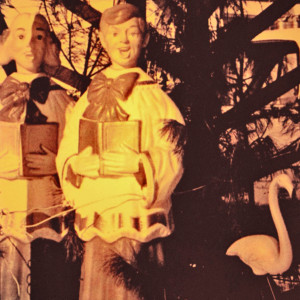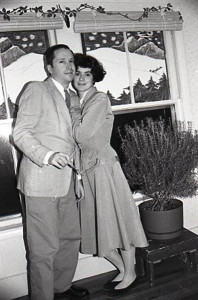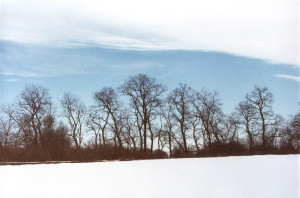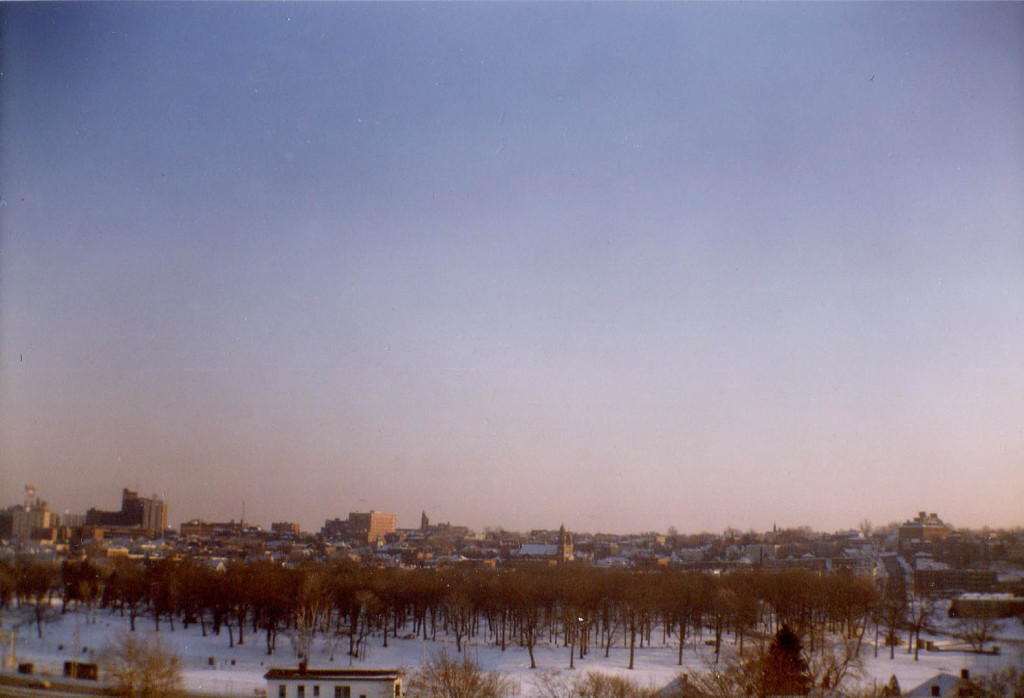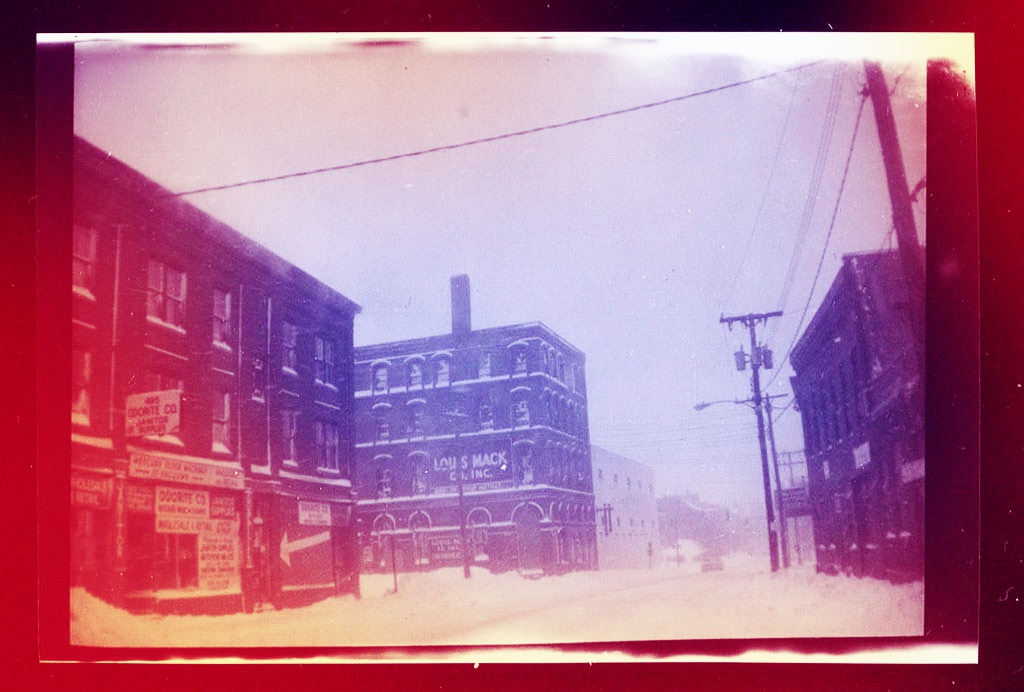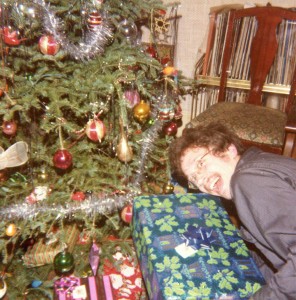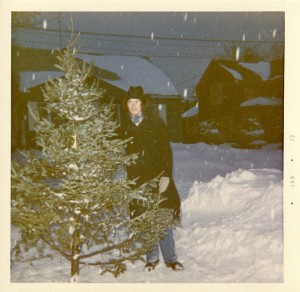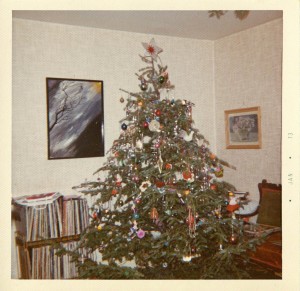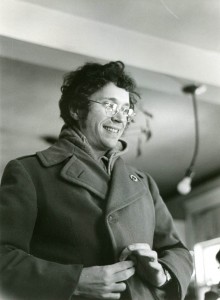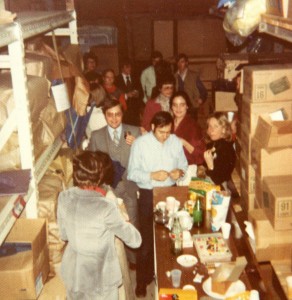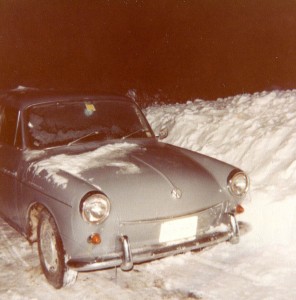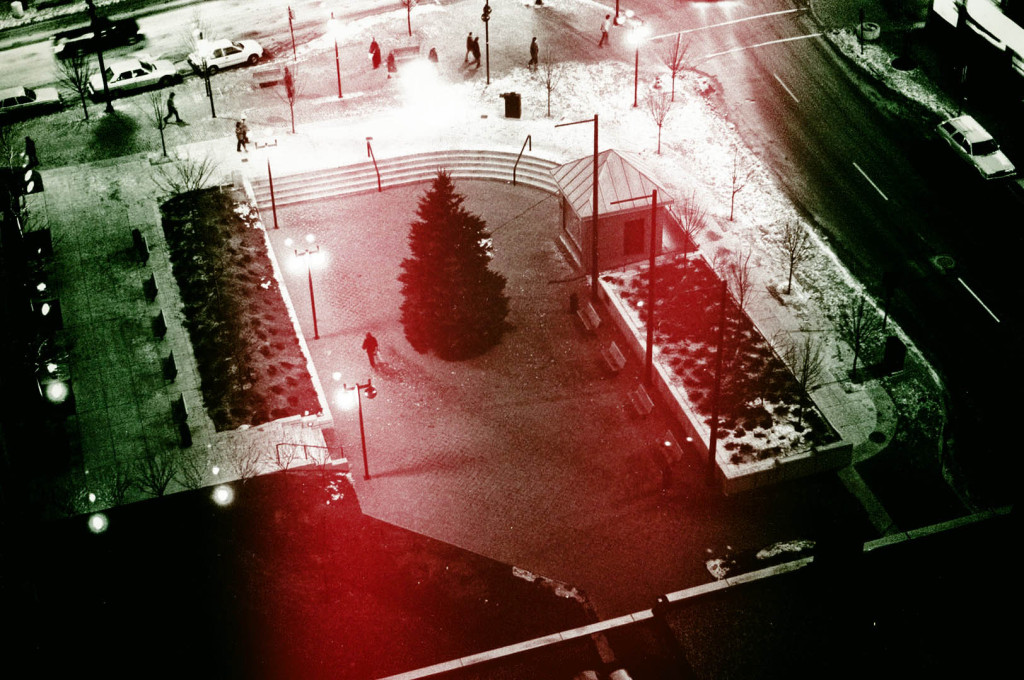
A digitally manipulated view of Congress Square Plaza in Portland, Maine, from the Top of the East in December 1984. Hubley Archives.
The swinging new release Obsessive Christmas Disorder makes a great Christmas gift!
If you were in a band with me back in the day, certain Christmas obligations came with the job.
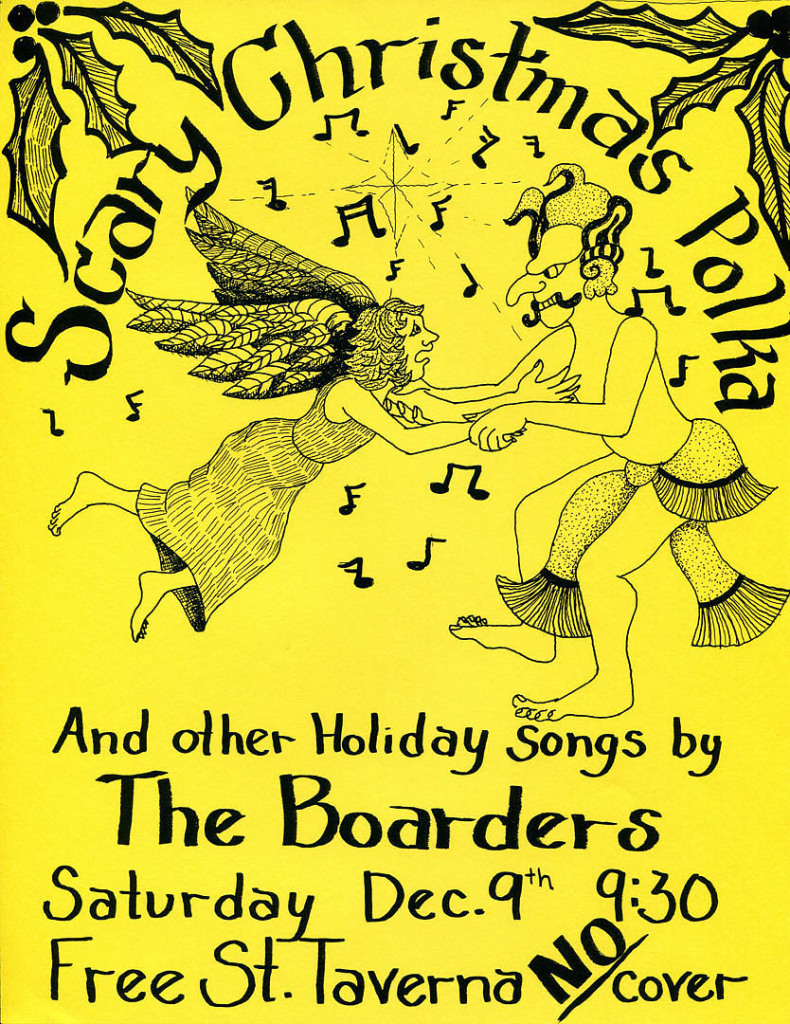
The Boarders’ multi-talented bassist, Gretchen Schaefer, created the poster for this 1995 gig. Hubley Archives.
The Boarders and the Howling Turbines, in particular, tended to land December gigs (at the Free Street Taverna, natch) for which I would insist we play a few holiday numbers. Among them:
“Rocking Around the Christmas Tree” with a ska beat; the 16th-century German carol “Maria Durch ein Dornwald ging”; and my compositions “Scary Christmas Polka,” “Hedonistic Christmas,” “Looking for That Christmas Feeling” and “Don’t Want No Star on My Christmas Tree.”
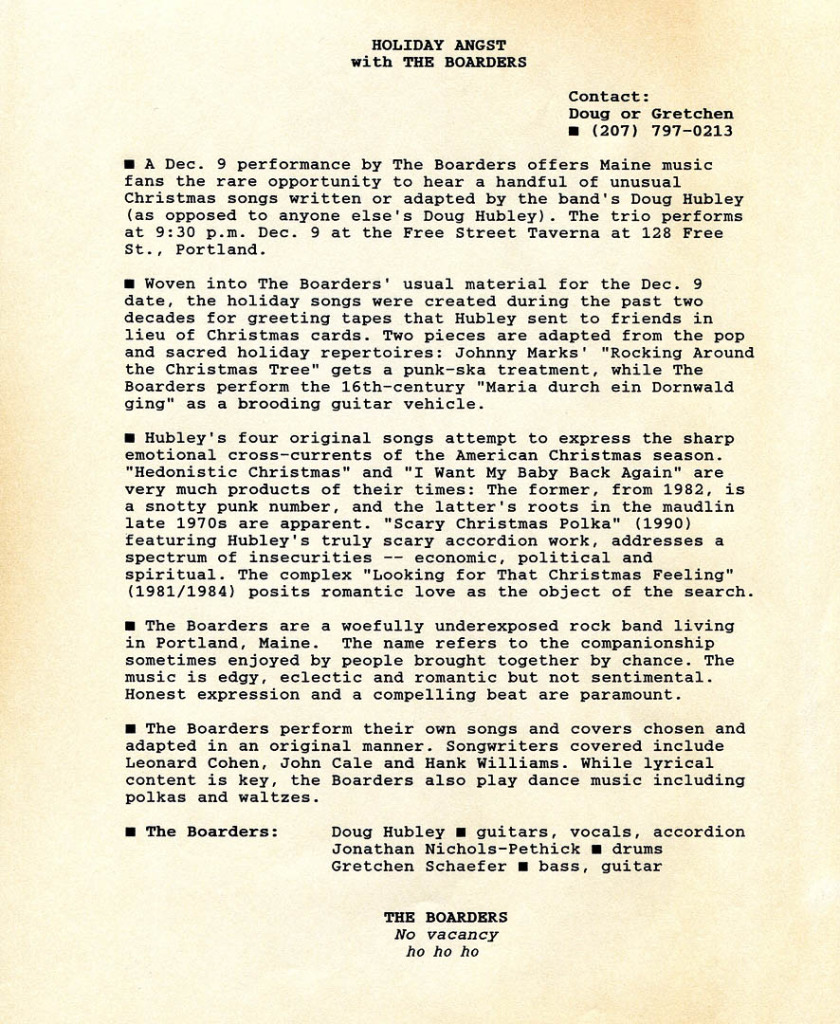
Our news release for the December 1995 Taverna performance. Hubley Archives.
My memories of these gigs are fragmentary: shoveling the driveway before a Boarders date that was complicated by the snow. Singing “Santa Claus,” a lyric I wrote to the tune, and inspired by the theme, of Leonard Cohen’s “Joan of Arc.” The Christmas lights against the Taverna’s brick walls and the chilling draft every time someone entered or left. Our friend Jeff Stanton propping himself up at a table as the evening grew late.
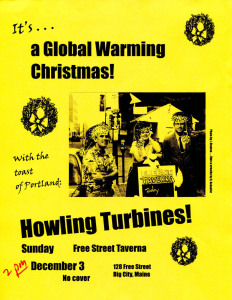
This Turbines poster for a December 2000 date was a group effort. Gretchen Schaefer created the Santa hats to superimpose on Jeff Stanton’s image of the Howling Turbines, taken at the Free Street Taverna on a 90-degree day. I wrote and laid out the poster. Hubley Archives.
For my bandmates — bassist Gretchen Schaefer, and drummers Jonathan Nichols-Pethick (Boarders) and Ken Reynolds (Turbines) — the Christmas gigs were gigs like others, just more festive and affording the chance to do material different from what we dragged around with us the rest of the year.
But in my mind there has been, since childhood, a link between Christmas and performing — though it’s also true that I never had enough community spirit, religious affiliation or even garden-variety empathy to frame my Yuletide performances in some broadly meaningful cultural context. (Even the currently popular holiday burlesque shows have that much going for them.)
Instead, I simply have old, random, but deeply felt sentiments for the season, and I simply hoped that I could present them in a way that, like an oddly dressed stranger speaking poor English who shows up in town on Christmas Eve, might elicit some fellow feeling.
As a pup I annoyed my family at dinnertime by talking into the telephone and pretending to be Santa Claus’ publicist (which perhaps anticipated my current work, which involves a lot of marketing). In a Christmas gift to all concerned, that phase was short. Odd that I was astute enough to know what a publicist did, but not enough to know how annoying I was.
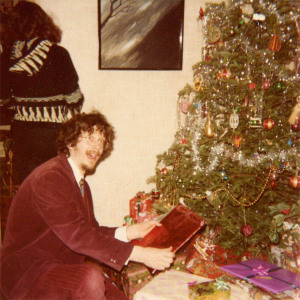
Me under the Hubley tree in the mid-1970s. My sister Nancy has her back to the camera. Hubley Family photo.
Later there were Christmas concerts with the Mahoney Middle School chorus, during one of which we performed the first song I ever wrote, “For Something’s Happened” — a calling-all-shepherds Christmas carol, though I knew even at age 12 or 13 that I was an atheist.
In 1973, the desire to put on a holiday show ascended to a new plane. That autumn, the nation was in the depths of Watergate, the first energy crisis, Vietnam and an emergent hangover from the cultural efflorescence of the 1960s. Gram Parsons and Jim Croce died — and Croce got all the mourning.
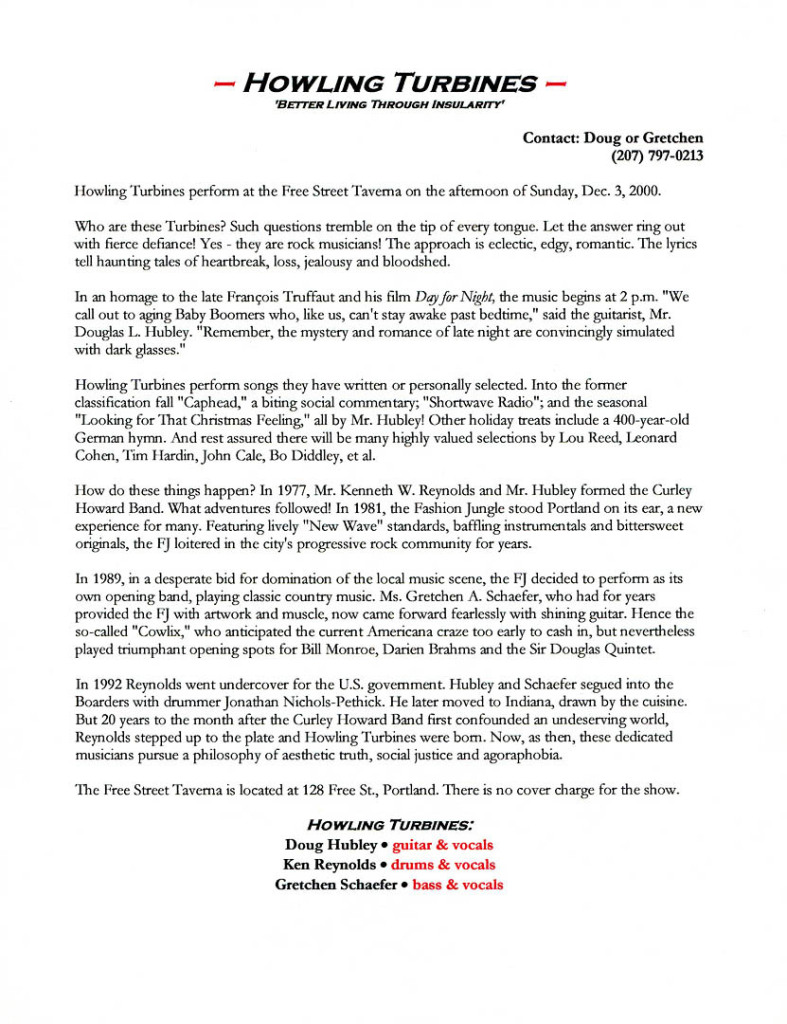
Who are these Turbines? Read it and find out, if you would be so bold! Hubley Archives.
I was unemployed, overweight, drinking too much, mourning my recently broken-up band, hanging around my parents’ basement and pining for romance. Clearly, it was time to put on a show! Somehow — I think through an invitation from the South Portland High School Keyette Club via my friend Patty Stanton — I ended up booked for the SPHS Christmas assembly.
No band? No problem! In my infinite ill-founded self-confidence, I used the Sony 540 reel-to-reel and my parents’ cassette deck to create backing tracks — drums, bass and guitar, all ineptly played by me and rendered in distorted meatball-as-pingpong ball multiple tracking — for four songs, which I sang and added live guitar to during the assembly. Not just once, but twice, in ’73 and ’74.
The songs: “White Christmas,” Charles Brown’s “Merry Christmas, Baby,” “Silver Bells” and Elvis Presley’s “Santa Claus Is Back in Town.” That one got some attention, at least according to my tape of the 1974 show.
Of course, responses to Christmas are complex, and my impulse to put on a show flew in formation with a squadron of other tendencies. (Trigger alert: Baby Boomer reminiscences follow.)
During the 1960s, I entered a holiday fugue state every November, a delirium inflamed by product lust encouraged by indulgent parents and the Sears, Roebuck Wish Book; and embellished with colorful Christmas-tree chiaroscuro, heart-rendering music and hearty sparkling TV specials. (The greed has spent itself, but the other components linger on.)
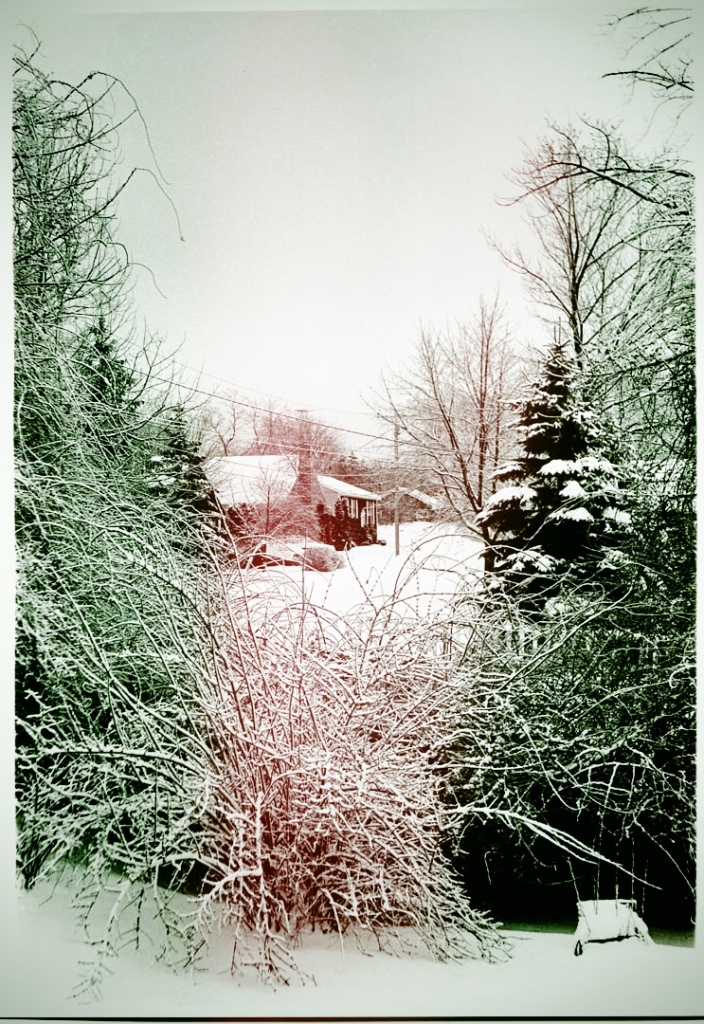
Digitally retouched to increase sentimental value, this is a view across the side yard at 103 Richland St., South Portland, Maine, where my family lived for many years. Harriette H. Hubley photo.
For a brief pre-teen period I practiced unspeakable (not perverted, just embarrassing) occult pre-Christmas rituals influenced by Tom Swift Jr. stories and TV spy series. These dictated specifically when I could take my Christmas stocking out of storage, put up my Christmas list, etc., etc.
Eventually I absorbed the idea that Christmas involved giving as well as getting. What an adjustment! Maturing at the same time was my innate neurotic responsiveness to deadlines. These traits converged at Christmas season to form compulsive, self-imposed sensations of obligation and urgency.
The buildup to the Big Day began to entail gift projects that inexorably led to late-night, last-minute labors that likely bore little relation to the holiday expectations of anyone around me.
All these psychological currents flowing through the Christmas season — the urge to perform, the sentimental reverberations, the self-imposed Big Projects — converged and blossomed forth in the Christmas Greeting Tapes, discussed in an earlier post, that I made for friends and family over the course of more than two decades.
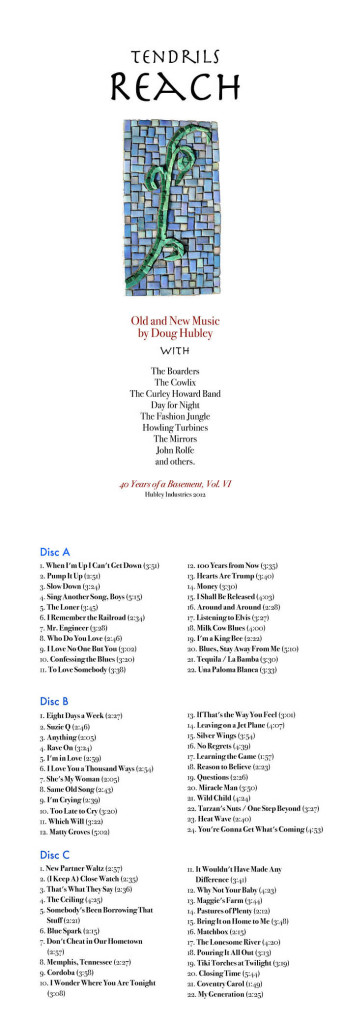
The front and back covers of the final entry in my CD compilation series, “40 Years of a Basement.” The mosaic is by Gretchen Schaefer.
All the songs that I expected my bands to perform at the Free Street Taverna and elsewhere, I had developed or adapted for the Christmas tapes.
These tapes were the mother of self-imposed Christmas obligations: Having done one, in 1974 (featuring recordings of the SPHS gig), I saw the creative potential and quickly developed the idea, purely out of thin air, that it was vitally important to keep making them — important not just to me, but to everyone I gave them to and, probably, to untold future generations, too. (I’m quite sure that people liked getting them, but really.)
All this is written in a retrospective tense, but don’t be fooled. True, the Christmas Greeting Tapes are long over with, and no one has offered a Christmas gig to my current band, Day for Night (we’ll take it! Please!!) — but the Christmas projects continue, albeit benefiting from somewhat less OCD and somewhat more refinement.
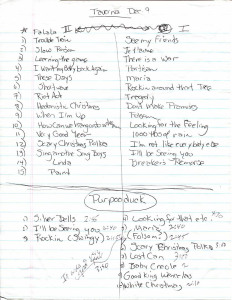
A combined setlist for two Christmastime 1995 Boarders dates: the Dec. 9 Taverna gig and a Rotary-sponsored performance for seniors at the Purpooduc Club. We played very quietly at that one. Hubley Archives.
You are reading the latest iteration of them, third in a series of Yule-themed Notes From a Basement blogs. Just prior to starting the blog, from 2005 through 2011, I produced on CD for family and friends annual compilations of music that those friends and I have recorded since the late 1960s.
In some ways the CD sets are realizations of unmet goals for the Christmas tapes. The seven compilations comprise 17 discs containing a total of 340 tracks played by 10 acts or artists. The sets are nicely annotated and illustrated, with five of them packaged in wordy (big surprise) 8.5-by-5.5-inch booklets. (Gretchen, thank you again for the long-reach stapler.)
I regret that I remember less about the Boarders and Howling Turbines Christmas performances, offered by a group of musicians for a group of people who wanted to hear what we were doing, than I do about the somewhat onanistic projects that preceded them by 20 years and more. And I would like to know more about our audiences’ responses to them, as that perhaps was a context in which my responses to Christmas made most sense.
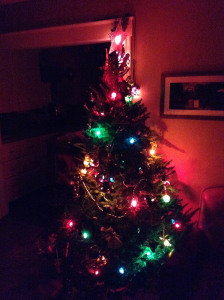
Hubley Archives.
Well, there’s always the WordPress comment option, folks. I’d love to hear from you. Meanwhile, another Christmas season is just beginning (or, according to whom you ask, several weeks along). A tree fell on our garage during the Nov. 26-27 snowstorm — we don’t yet know the damage but at least Gretchen was able to work in her studio, at the back of the garage, today — and I hurt my back shoveling snow, putting an end to my long-held conviction that I would never have back trouble.
Yet in a sign of progress, I feel grateful that in spite of all, we continue to enjoy great good fortune. And yes, I still feel vestigial stirrings of the old incoherent Christmas nostalgia, the deadline obsession and the need to show off in a seasonally appropriate way.
I say to those feelings and to you who have come this far reading about them: fond greetings, old friends. And to you who are reading, I also wish contentment with, or at least acceptance of, your own Christmas complications; and much happiness in the company of those who stay with you in spite of them.
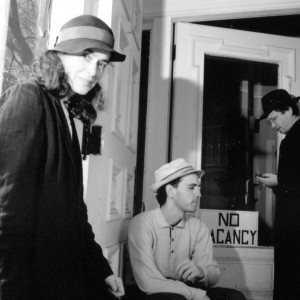
The Boarders in an autumn 1994 Boarders publicity shoot by Jeff Stanton. Hubley Archives.
Compare and contrast! Available on Bandcamp, hear The Boarders and the Howling Turbines offer their distinctive interpretations of a few holiday numbers. As an added bonus, or something, there are two accordion numbers and an excerpt from the 1984 Christmas Greeting Tape.
- Looking for That Christmas Feeling (Hubley) This performance is by the Boarders, in a Dec. 6, 1995, rehearsal for our Christmas date at the Free Street Taverna. Doug Hubley, guitar and vocal. Jonathan Nichols-Pethick, drums. Gretchen Schaefer, bass. Song note: In December 1981, I was stressed by finals and the demise of my current band, the original Fashion Jungle —but also all electrified by my new affair with Gretchen. That peculiar tension informs this song exploring the longing for some kind of meaning to Christmas that didn’t involve, well, Christ. Like “Shortwave Radio,” also from 1981, this involves closely personal imagery (I drank a lot of Freixenet that year), but I nevertheless hope it is somehow meaningful to others as well. The intro came later, in 1984 — coincidentally, again coinciding with the dissolution of a Fashion Jungle seemingly poised on the brink of success. The opening image was provoked by a spell of December warmth that had me worried about global warming even then. “Looking for That Christmas Feeling” copyright © 2010 by Douglas L. Hubley. All rights reserved.
- Maria Durch ein Dornwald Ging (trad. German) In the late 1980s I abandoned the skit+music format of my Christmas Greeting Tapes and instead produced little compilations of Christmas music played on accordion. Recorded on a Sony Walkman through a mic the size of a bullion cube, this is a solo performance of a German carol from the 15th or 16th century. The words depict Mary, pregnant with the Birthday Boy, wandering through a thicket of seemingly dead roses (a “thorn woods”) that burst into flower as she passes. Recorded Dec. 21, 1988.
- Maria Durch ein Dornwald Ging (trad. German) From an Oct. 10, 2001, rehearsal by the Howling Turbines. Doug Hubley, guitar and vocal. Ken Reynolds, drums. Gretchen Schaefer, bass. Song note: This German carol made a very fine addition to the holiday repertoires of both the Turbines and the Boarders, which first developed the electric version (see below).
- Sel bych rad k Bethlemu (trad. Czech) Another accordion piece from the music-only Christmas tapes. The title of this Czech carol means “to Bethlehem I would go” and the lyrics are aimed at children. I liked the tune and, added bonus, I could play it. Also recorded Dec. 21, 1988.
- Looking for That Christmas Feeling (Hubley) The Howling Turbines on Oct. 10, 2001, rehearsing for a Christmastime date at the Free Street Taverna. Doug Hubley, guitar and vocal. Ken Reynolds, drums. Gretchen Schaefer, bass. “Looking for That Christmas Feeling” copyright © 2010 by Douglas L. Hubley. All rights reserved.
- Maria Durch ein Dornwald Ging — The Boarders, rehearsing on Dec. 5, 1995, for a Free Street Taverna gig a few days hence: Doug Hubley, guitar and cheezy double-tracked vocal. Jonathan Nichols-Pethick, drums. Gretchen Schaefer, bass.
- “Coffee With Doug”: Christmas Around the World — An excerpt from one of the more successful entries in the Christmas Greeting Tape series, from 1984.
“Notes From a Basement” text copyright © 2012–2014 by Douglas L. Hubley. All rights reserved.
Posted in
Boarders,
Christmas,
Early Years,
Fashion Jungle,
Howling Turbines,
Pre-Band Years and tagged
Christmas Greeting Tapes,
Doug Hubley,
Free Street Taverna,
Gretchen Schaefer,
Jonathan Nichols-Pethick,
Ken Reynolds,
Mahoney Middle School,
Portland Maine music,
The Boarders,
Top of the East
